- Nature / Scenery
- History / Culture
- Traditions / Performing Arts
- Experiences
Forge Your Blade: A Blacksmith Experience near Himeji
Contributor : Kristina
If you’ve ever dreamed of entering the world of Japanese swordsmithing, I recommend visiting the Kikyo Hayamitsu Japanese Sword Smithy in Hyogo Prefecture. It’s just a 20-minute train ride from Himeji, offering a unique hands-on experience in traditional blacksmithing.
I recently had the opportunity to visit for the first time, and it was unlike anything I’d ever done before. This immersive program introduced me to a craft passed down for over a thousand years, from heating glowing steel to hammering and shaping my blade. The experience was fascinating, humbling, and surprisingly therapeutic.
Here’s why this knife-making experience is one you can’t miss, along with tips on how to make the most of your visit.
Easy Access to the World of Japanese Sword Craftsmanship
The Japanese katana is more than just a sword—it symbolizes Japan’s history, precision, and artistry. Though no longer used as weapons, their form and beauty have remained unchanged for centuries and are now revered as works of art.
I’ve always been fascinated by the craftsmanship behind Japanese swords. When I discovered visitors could try their hand at forging a blade with a real swordsmith, I knew I had to go. My journey led me to Aioi Station, a stop on the Sanyo Shinkansen Line (Hikari and Kodama services), making it an easy and convenient destination for travelers from Osaka, Hiroshima, or even Tokyo. You can also reach Aioi Station with a 20-minute train ride from Himeji on the JR Sanyo Main Line.
From Aioi Station
● Take the Shinki Bus Spring8 Line:
○ Get off at Uryu Higashi Bus Stop → Walk 15 minutes through the picturesque countryside.
● By Taxi
○ A taxi ride from Aioi Station to the sword smithy takes approximately 20minutes.
Workshop at Kikyo Hayamitsu Sword Smithy
After a peaceful 15-minute walk from Uryu Higashi Bus Stop, I found myself in Rakan-no-Sato, a tranquil nature park in the heart of Aioi. Even in the quiet chill of December, the place felt magical—silent and serene. I could easily picture it as a cool retreat during the summer, but in winter, it carried a calm stillness that felt almost otherworldly.
As I followed the path along a small stream, I spotted the workshop: an old wooden forge tucked away among the trees. It looked like something out of a movie, blending perfectly into its natural surroundings
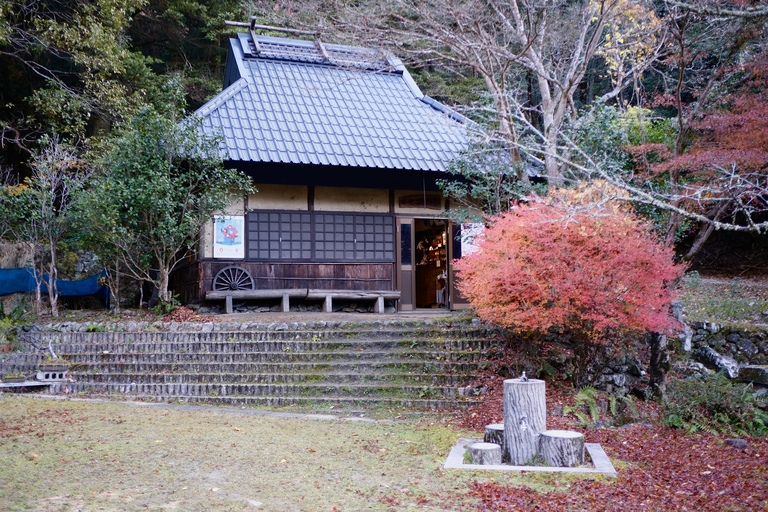
An old wooden forge tucked away among the trees
Master Kikyo Hayamitsu, a swordsmith with decades of experience, welcomed me into his workshop. Surprisingly, Kikyo-san didn’t grow up with a love for swords. His journey began after watching a TV program on sword-making, which sparked his curiosity. This led him to visit the Osafune Sword Museum in Okayama, where he met his mentor, Yokoi Takamitsu, and decided to apprentice under him. Since opening his workshop in Rakan-no-Sato, Aioi City, in 2010, Kikyo-san has mastered this technique and participated in prestigious exhibitions such as the Omamorisword exhibition.
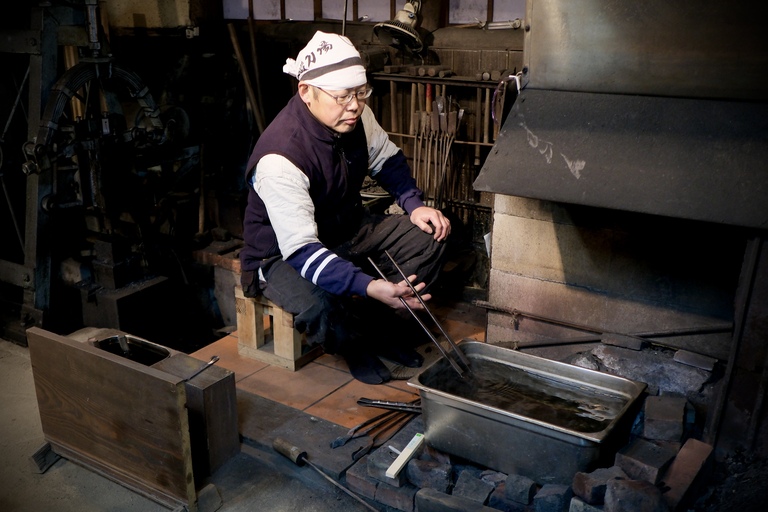
Master Kikyo Hayamitsu, a swordsmith with decades of experience
Kikyo-san stands out because of his ability to connect with visitors from around the world. He has welcomed over 150 international guests annually, using a translation app to guide them through the process in English, Italian, and Chinese etc. Pretty impressive, right?
My Blacksmithing Experience
I had never in my wildest dreams imagined that I’d one day forge a blade. To say I was nervous would be an understatement—I worried I wouldn’t get it right or might ruin the process entirely. But from the moment I met Master Kikyo Hayamitsu, all those fears disappeared. His calm, kind, and patient guidance made me feel completely at ease as if I’d done this a hundred times before.
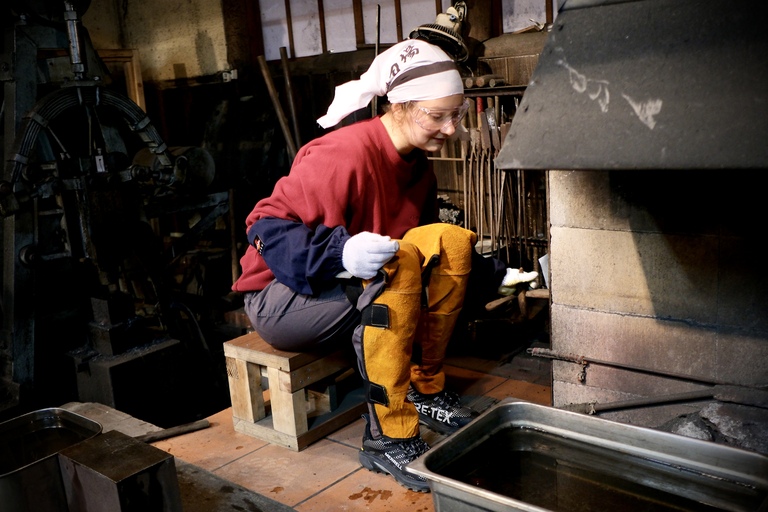
I had never in my wildest dreams imagined that I’d one day forge a blade!
The experience began with wearing protective gear—trousers, sleeves, and safety glasses. Then, it was time to step into the forge and experience the centuries-old craft of blacksmithing firsthand. The process was intense, but I’ll break it down into simple steps:
1. Heating the Steel (火造り - Hizukuri)
The first step was to heat the pre-shaped steel using a traditional bellows tool called a 'fuigo,' which is used to blow air and make the fire stronger. Kikyo-san expertly fanned the flames using a fuigo, and I watched, mesmerized, as the steel slowly turned a glowing fiery red. His precision and control of the forge were incredible, like watching an artist at work.
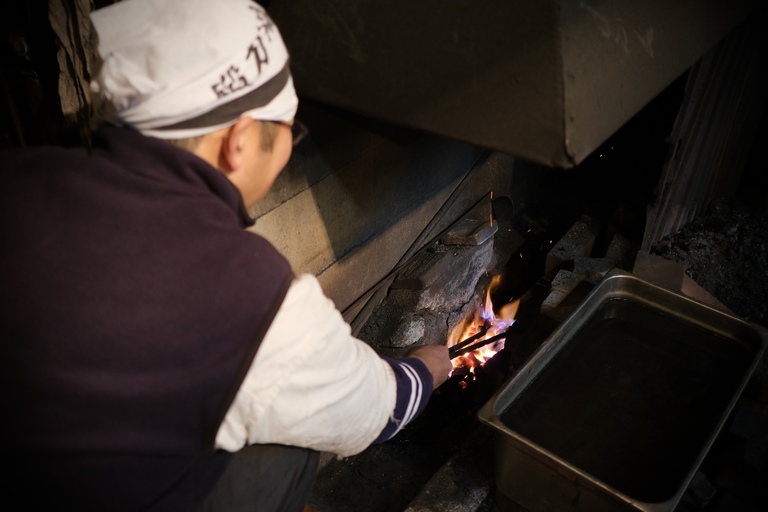
Step 1: Heating the Steel
2. Shaping the Blade(火造り - Hizukuri)
Once the steel was hot enough, it was time for me to step up. Under Kikyo-san’s careful guidance, I picked up the hammer and began shaping the blade. This part was far more challenging than it looked. You need to hammer the steel while holding the hammer at a consistent angle and simultaneously pulling the blade back to stretch it into shape.
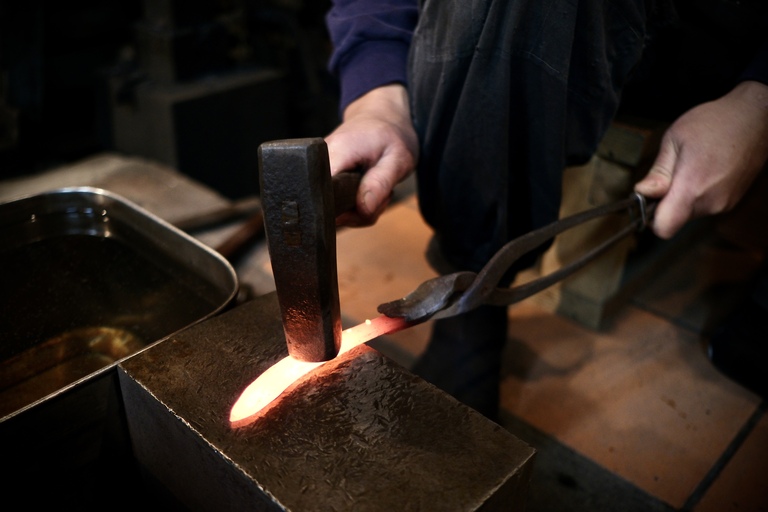
Step 2: Shaping the Blade
At first, I struggled. My strikes were uneven, and I worried I wasn’t making progress. To keep steady, I started counting—“one, two, three”—until I reached ten, trying to fall into the rhythm of the process. Slowly but surely, I gained confidence, and the sound of metal on metal became oddly soothing, like a melody from another time.
3. Filing the Blade (ヤスリがけ)
With the rough shape complete, we moved on to grinding. Using a grinder, the master carefully smoothed out the edges and surface of the blade. This step required precision and patience, but I could see the blade starting to take on its final form.
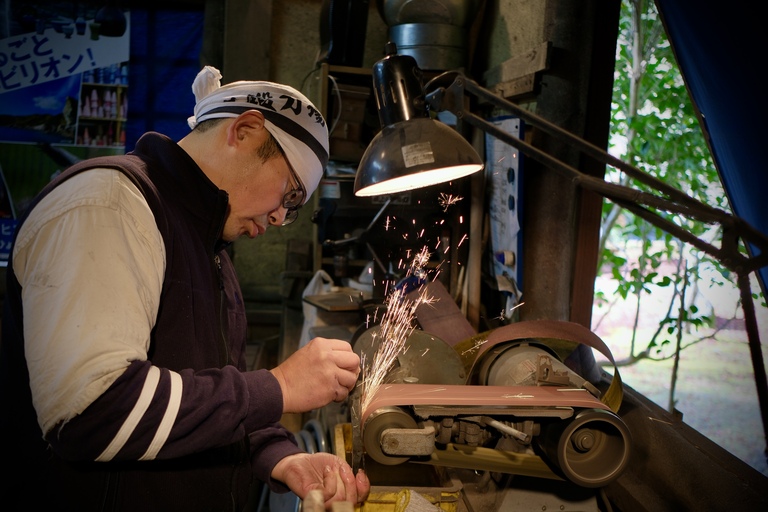
Step 3: Filing the Blade
4. Quenching (焼き入れ)
This is where the real magic happened. Kikyo-san explained that heating the blade to around 800°C and rapidly cooling it in water strengthens the steel, giving it durability. Before quenching, the blade was coated with yakibatsuchi, a special clay that distributes heat along the blade. For katanas, it creates intricate hamon patterns—those wavy lines you see on traditional Japanese swords.
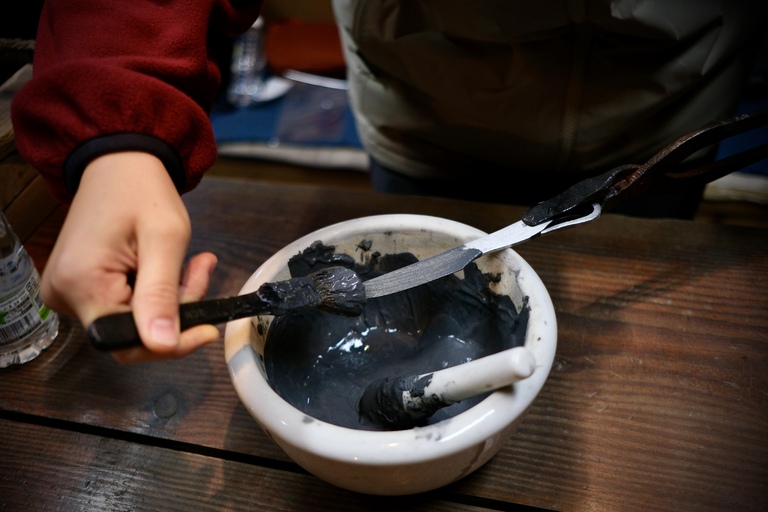
Step 4: Quenching with yakibatsuchi, a special clay that protects the blade
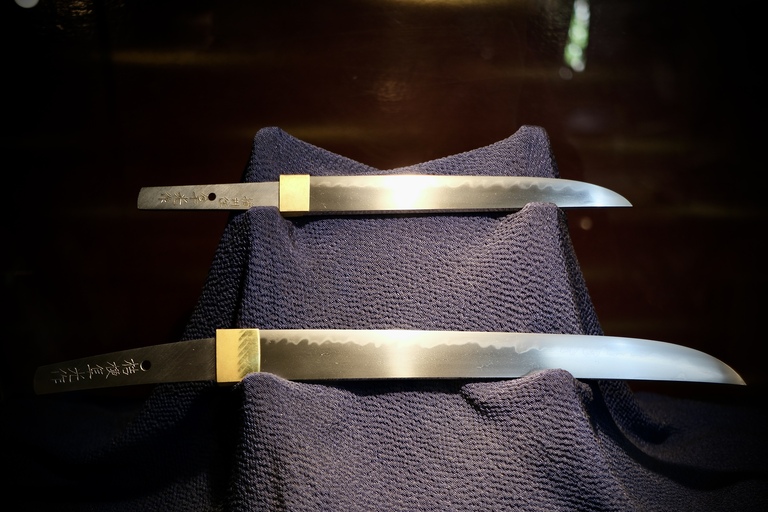
For katanas, the quenching is used to create intricate hamon patterns
During our workshop, the focus was on creating a strong, practical blade that would last for years. Kikyo-san heated the blade until it glowed red-hot and, plunged it into the water with a precise motion. The loud hiss and cloud of steam were exhilarating to witness. Swordsmiths describe this step as “breathing life into the blade,” and at that moment, I truly understood what they meant.
5. Polishing the Blade (研磨)
Finally, it was time to refine the blade. I carefully polished and sharpened the edges using whetstone under Kikyo-san’s supervision. It was a slow, meditative process, and the blade began to gleam with each stroke.
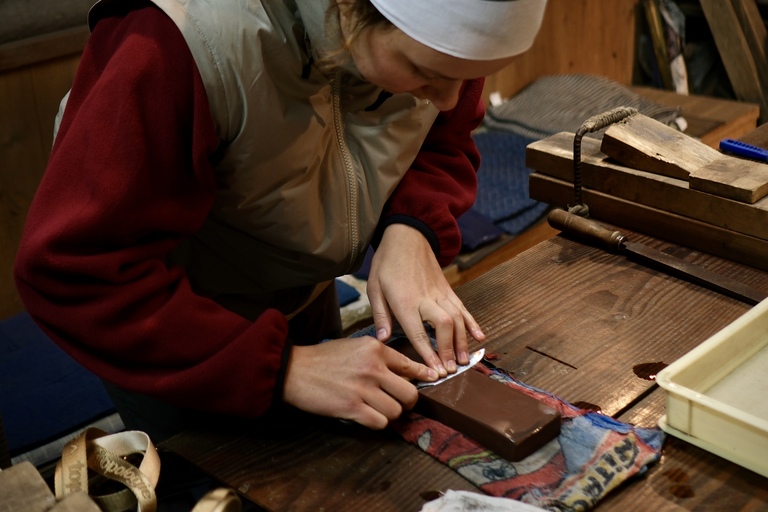
Step 5: Polishing the Blade
The finishing touch was engraving my name onto the blade—transforming it into a one-of-a-kind keepsake. It felt surreal to hold something I had shaped with my own hands!
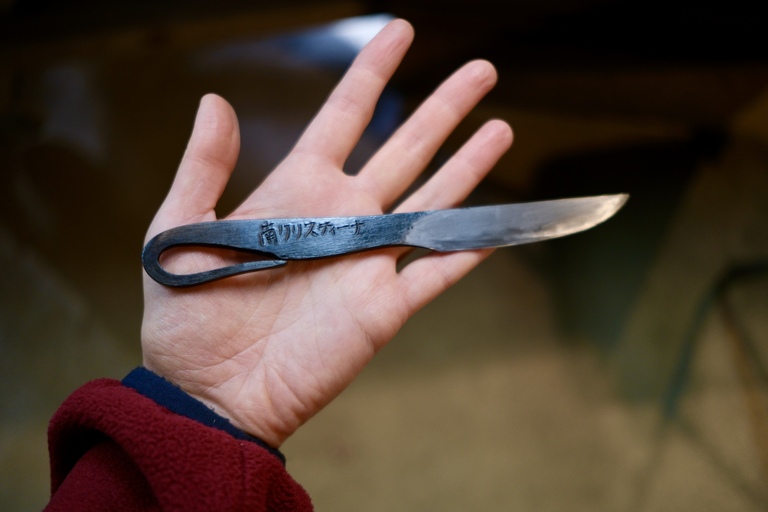
I can’t believe I made my own knife with my name on it
As a final touch, Kikyo-san let me choose a case for my knife. He carefully placed the finished blade into a beautiful leather case. Holding it in my hands, I felt pride and accomplishment like never before.
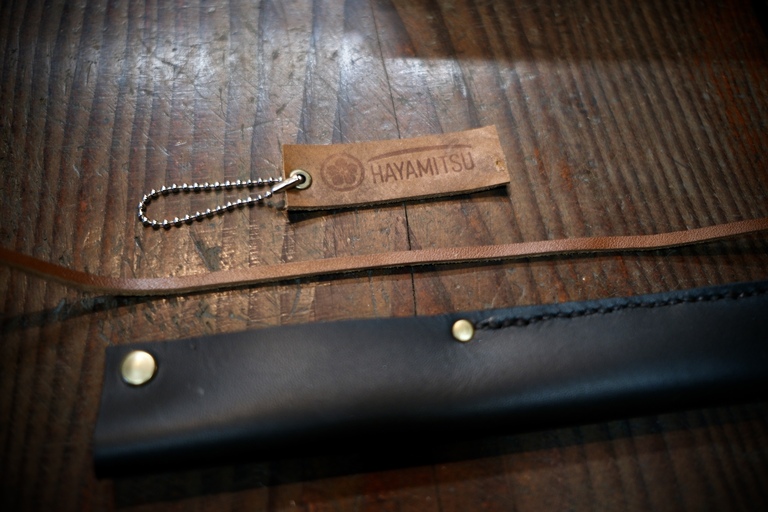
As a final touch, Kikyo-san let me choose a case for my knife
It wasn’t just a knife—a piece of history, a tangible connection to centuries of Japanese craftsmanship. And I had made it myself. On my own! Just wow.
Practical Information
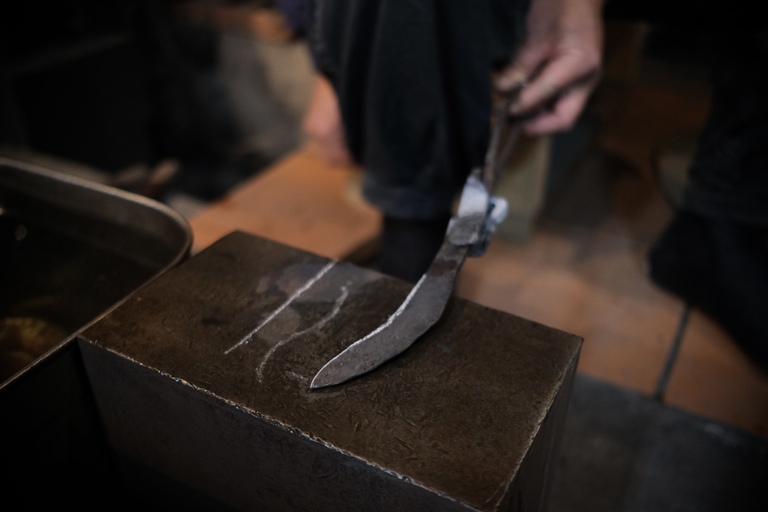
●Location: Kikyo Hayamitsu Sword SmithHayamitsu Sword Smithy, Aioi City, Hyogo Prefecture
● Price: ¥12,000 (includes leather case and bottled water)
○ Optional: Wooden box (¥1,000), Tamahagane knife-making (¥48,000, 4 hours)
● Duration: Approx. 4 hours
● Participants: Minimum 1, maximum 3
●Booking: Reservations required 7 days in advance. Make your reservation here!
○Contact:090-8358-4748| kikyo@hayamitsu.com
○Website: https://www.hayamitsu.com
Final Thoughts
As I made my way back to the bus stop, I still couldn’t quite believe it—I had forged my own knife! My time at Kikyo Hayamitsu’s workshop felt almost surreal, like stepping back in time and becoming part of Japan’s living history. Experiences like this, where you can immerse yourself deeply in a centuries-old tradition, are incredibly rare, and this was indeed one of those unforgettable moments.If you’re traveling through Hyogo Prefecture, add this to your itinerary! you won't want to miss his blacksmith workshop in Aioi City



